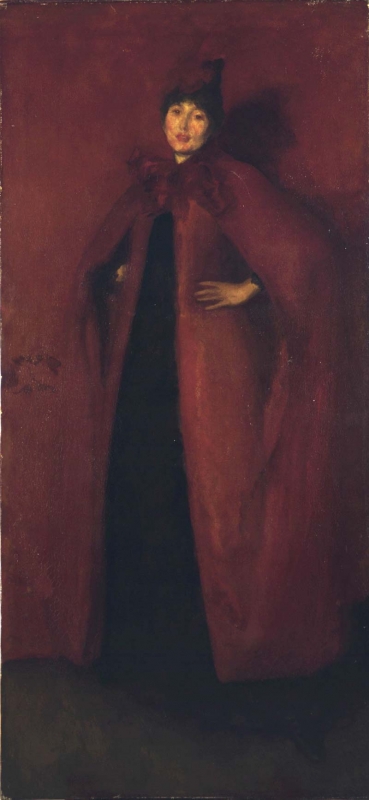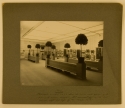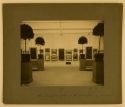Home > Catalogue > Browse > Harmony in Red: Lamplight << >>
Provenance
- 1903: in Whistler's studio at the time of his death, and bequeathed to his ward and executrix, Rosalind Birnie Philip (1873-1958);
- 1935: given by Miss R. Birnie Philip to the University of Glasgow.
Exhibitions
- 1886: Winter Exhibition, Society of British Artists, London, 1886 (cat. no. 227) as 'Harmony in Red. Lamplight'.
- 1904: Oil Paintings, Water Colors, Pastels and Drawings: Memorial Exhibition of the Works of Mr. J. McNeill Whistler, Copley Society, Boston, 1904 (cat. no. 47) as 'Harmony in Red. Lamplight'.
- 1905: Œuvres de James McNeill Whistler, Palais de l'Ecole des Beaux-Arts, Paris, 1905 (cat. no. 23) as 'Harmonie en rouge; éclairage de lampe – Portrait de Madame J. McNeill Whistler – (Harmony in Red. Lamplight. Portrait of Mrs J. McNeill Whistler)'.
It was shown at the Society of British Artists in 1886, during the period of Whistler's presidency. In Whistler's pictures at the Society of British Artists [M.1127] Whistler drew the gallery to show how this picture was hung, as well as the surrounding décor. 1

J. Bernard Partridge, At the Whistleries, Suffolk Street, drawing for Judy, Fogg Art Museum, Cambridge, MA
The painting was the subject of a caricature in Judy, 8 December 1886: it is at upper right of a page mainly devoted to Whistler's exhibits.
The critic of The Magazine of Art mixed praise and criticism:
'Another large canvas is the "Harmony in Red: Lamplight" in which the gradations of a delicate red, softened, and as our neighbours would put it, "assagi" by a deadened lamplight, are produced with great skill and enjoyment. But, again is it justifiable to employ for a technical exercise of this kind so vast a canvas? and are not the folds of the cloak worn by the female figure, which is the pretext for the harmony, needlessly ungraceful?' 2
More succinct, but not more flattering, The Daily News called it 'a technical triumph, although not exactly a very beautiful representation.' 3
The Pall Mall Gazette described it even more briefly as 'a portrait of Mrs Godwin, by lurid lamplight.' 4 The lighting described here as 'lurid' appeared only 'assagi' (subdued) to the Magazine of Art and the London Evening Standard. However, the art critic of the latter, reflecting middle-class prejudices, was critical of the model's pose, implying that it verged on vulgar:
'a tall woman's figure ... the hand on the hip, in an attitude that Mr. Whistler loves – an attitude that, before the days when women were muscular and their movements free, used, at all events among very proper people, to be thought not quite a fitting thing for a lady. ' 5
These mildly dismissive reviews might have led Whistler to limit exhibitions of the portrait. In 1886 or 1887 Whistler listed 'Mrs. Godwin' among his 'Big pictures', probably as a potential exhibit in a proposed one-man exhibition at the RBA, which never materialised, because he was forced to resign as President of the Society. 6
In 1887 Claude Oscar Monet (1840-1926) wrote to Théodore Duret (1838-1927) that the sculptor Auguste Rodin (1840-1817) admired a portrait, described as 'femme en rouge', which may have been this portrait, and Monet hoped it would be exhibited at the Galerie Georges Petit:
'[O]n m'a parlé de son portrait de femme en rouge. Rodin me dit que c'est superbe, et une feerie je lui en parle pour qu'il fasse son possible pour nous l'envoyer ... il ferait bien car là il sera [autrement?] bien vu qu'au Salon.'
Translated: 'I have been told of his portrait of a woman in red. Rodin tells me that it is superb, and a magical piece, I am writing to him to ask him to do his best to send it to us ..., it would be good for him as he would be more highly regarded there than at the Salon.' 7
Eventually Whistler sent a substantial group of work – some fifty paintings, watercolours and pastels – to the Exposition Internationale de Peinture et de Sculpture at the Galerie Georges Petit, Paris, in 1887, but not this portrait, nor did he send it to the Salon. Instead he sent a portrait of Maud Franklin, Harmony in Black, No. 10 [YMSM 357], to the Exposition Internationale.
The photographs reproduced here show the portrait on exhibition in Boston in 1904.
Due to the terms of Miss Birnie Philip's gift to the University of Glasgow, the painting cannot now be lent to other venues.
Notes:
1: MacDonald 1995 (cat. rais.) [more], p. 415 (cat. no. 1127).
2: Magazine of Art 1887 [more], at p. 111.
3: Anon., 'The Society of British Artists', The Daily News, London, 30 November 1886 (GUL Whistler PC7 p. 18).
4: Anon., 'The Society of British Artists', Pall Mall Gazette, London, 30 November 1886. (GUL Whistler PC7 p. 67).
5: Anon., 'The Winter Exhibitions', London Evening Standard, London, 30 November 1886 (press cutting in GUL Whistler PC 7 p. 59). See Robins 2007 [more], pp. 79-80.
6: [1886/1887], formerly dated [4/11 January 1892], GUW #06795.
Last updated: 31st December 2020 by Margaret









